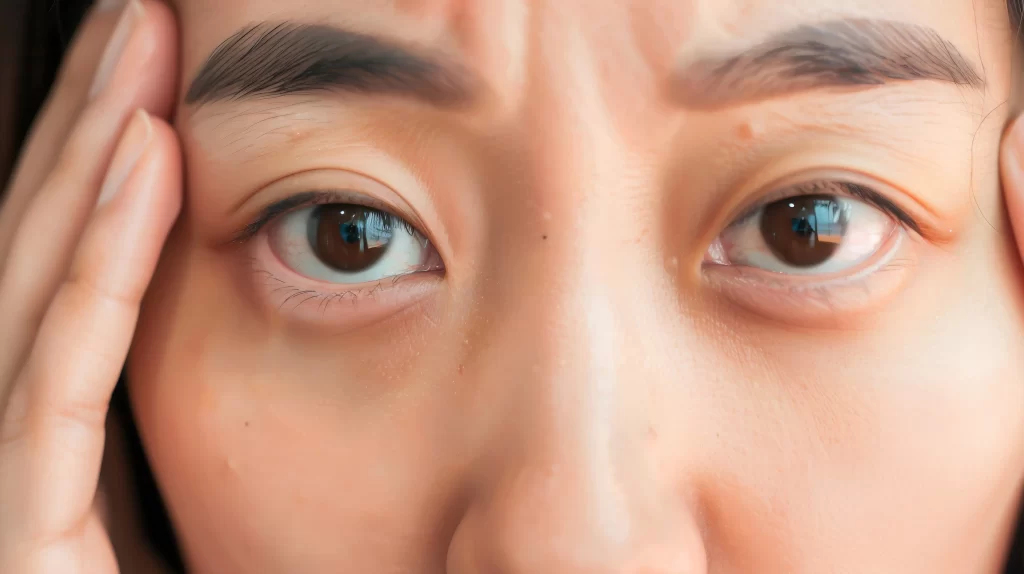
Most people assume that eye bags are simply the result of a poor night’s sleep. While fatigue does play a role, under-eye puffiness can also stem from various lifestyle choices and health issues.
Read on to know more about these overlooked factors and the treatments you can consider to restore the vitality of your eyes.
How you sleep can affect the way fluid accumulates around your eyes. Lying flat or sleeping on your stomach encourages fluid to pool in the under-eye area, especially overnight. This gravitational effect can lead to puffiness in the morning.
Tip: Sleep on your back with your head slightly raised using an extra pillow. This helps reduce fluid retention and encourages better drainage.
A high sodium diet causes the body to retain water, particularly in sensitive areas such as the face and under the eyes. Processed foods, instant noodles, chips, and restaurant meals often contain more salt than we realise.
Tip: Monitor your salt intake and aim to cook more at home using fresh ingredients. Increasing your water consumption can also help flush excess sodium from your system.
Alcohol dehydrates your body, which can cause the delicate skin under your eyes to appear sunken or wrinkled. At the same time, it may lead to fluid retention the next day, resulting in puffiness or swelling.
Tip: Moderate your alcohol intake and drink water in between alcoholic beverages. Ensuring you’re well-hydrated before going to bed can also reduce the morning-after puffiness.
If you have allergies or chronic sinus issues, you may experience constant under-eye swelling. Inflamed sinuses can impede proper lymphatic drainage in the eye area, leading to fluid accumulation.
Tip: Treating your sinus condition with antihistamines, nasal sprays, or saline rinses can help relieve pressure and improve drainage. You can also consider allergy testing to identify environmental triggers.
Your lymphatic system functions to clear waste and excess fluid from tissues. If this system isn’t working efficiently, whether due to a lack of physical activity or medical conditions, fluids can accumulate under your eyes.
Tip: Gentle facial massage, lymphatic drainage techniques, and regular exercise can all encourage better circulation and fluid movement. Professional facial treatments may also offer targeted lymphatic stimulation.
Hormones affect fluid balance and skin elasticity. For women, menstrual cycles, pregnancy, and menopause can bring about fluctuations in oestrogen and progesterone levels, which, in turn, trigger eye puffiness.
Tip: Tracking hormonal patterns may help you understand when puffiness is likely to occur. A consistent skincare routine and staying well-hydrated can minimise its effects.
Looking at screens for extended periods puts strain on your eye muscles, especially if you aren’t blinking enough. This can lead to inflammation and dark circles, and contribute to puffiness due to poor circulation.
Tip: Follow the 20-20-20 rule—every 20 minutes, look at something 20 feet away for 20 seconds. Adjust screen brightness, use anti-glare filters, and remember to blink often.
Collagen helps maintain skin structure and firmness. As we age, natural collagen production decreases, resulting in thinner, sagging skin under the eyes. This makes fluid retention and fat deposits more noticeable.
Tip: Stimulate collagen production with skincare products containing retinoids, peptides, or vitamin C.
Smoking reduces blood flow to the skin and damages collagen and elastin fibres, accelerating skin ageing. It also dehydrates your skin, making eye bags and dark circles more prominent.
Tip: Quitting smoking will benefit your overall skin health. In the meantime, use antioxidant-rich skincare to protect against free radical damage.
Persistent eye bags don’t have to be your reality. At DermClear Aesthetic & Laser Clinic, we offer a range of non-surgical solutions for under-eye concerns, personalised to your needs.
We can help you uncover the root cause of your eye bags and guide you through a suitable treatment so you can wake up each day looking refreshed and confident.
Book a consultation with us today.